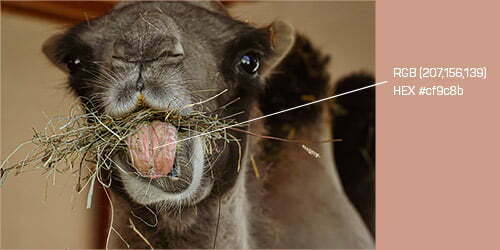Camel’s tongue plays a big role in camel’s daily life.
Similar to the tongues of other mammals, the camel tongue is elongated and helps with food consummation.
This article will look into basic characteristics of the tongue, like its length, color, weight, and similar.

Table of Contents
Key Points
- The camel’s tongue is essential for tasting, manipulating, and consuming food.
- It is soft, flexible, and consists of three parts: apex, body, and root.
- The tongue has various types of papillae, including those for taste.
- Camels have adapted to eat thorny plants, with tough tongues and teeth to prevent injuries.
- The camel’s tongue is pale pink and grey in color.
Camel Tongue
Camel’s tongue is a very important organ for the animal. It is a highly moving, muscular organ that helps with tasting, grasping, chewing, manipulating, and food swallowing.
It is soft and highly flexible.
It consists of three parts:
- apex (cranial part)
- body (middle part)
- root (caudal part)
The cranial part of the tongue is flat, and oval at its base.
An important part of a camel’s tongue is the papillae, conic structures that are partially keratinized, covering the surface of the organ, and protecting the inside of the mouth.
There are 4 types of papillae in camels.
For example, the tongue is in part covered with five large-diameter circumvallate papillae, ones that contain lots of taste buds and allow the animal to taste the food it is eating. Four of them are located on the right side and five on the left side of the tongue, mostly towards the back part.
The tongue also contains a lot of filiform papillae, structures that have different heights and thicknesses but do not have any tasting functions.
In addition to those 2, the camel’s tongue also has fungiform (located at the front of the tongue) and lenticular papillae, as shown by a study of camel tongues.

Figure: Photograph of dorsal surface of tongue of camel showing circumvallate papilla. Cv -Circumvallate papilla, LCpLarge conical papilla, SCp -Small conical, LLp -Large lenticular papilla, SLp -Small lenticular papilla. | Source: Researchgate.net
According to a different, 2016 study, the camel tongue is being moved by 3 main muscles that are covered by a mucous membrane:
- Styloglossus muscle – pulls the tongue caudodorsally and shortens it
- Hyoglossus muscle – pulls the tongue caudoventrally
- Genioglossus muscle – pulls the tongue forward and ventrally
Those 3 muscles allow the animal to move it up, down, left, and right.
The organ connecting the tongue with the floor of the mouth is the frenulum.
Compared to the size of the animal, the camel tongue is relatively small and weighs around 2 pounds (0.9kg) which is only 0.16% of the total camel weight.
Before they are even born, in the first 2-3 months of their development, camels develop taste and non-taste buds on their tongues. In the remaining growth period before being born, the tongue continues to grow.
In a study published in Sokoto Journal Of Veterinary Sciences, camel tongue length is around 17 inches (43cm).
Because of their softer tongues, when it comes to camelids that are in zoos and private farms, a softer block of salt licks should be provided to the animal. Also, regular checks of the mouth are required, as lots of seeds tend to get under the tongue.
Camel Tongue Color

When it comes to camel tongue color, a question lots of people ask is: do camels have black tongues?
Black is not the real color of the camel’s tongue.
According to animal experts, the camel’s tongue color is a pale pink and grey one.
Another misconception people make is mistaking camel’s tongue for camel’s dulla, which is a pink organ resembling a tongue that hangs on a side of the camel’s mouth, typically during the breeding season.
Further reading: The dulla of a camel
Why Do Camels Have Tough Tongue And Teeth?
Camels have developed tough tongues and teeth in order to survive in deserts and be able to feed on thorny plants, bushes, and other sharp shrubs.
Dromedary one-humped camels usually inhabit territories with deserts.
Usually, food in such places is scarce and usually very thorny (think of cactuses).
In order to survive in such places, camels had to adapt to eating food that was available.
In order to eat thorny plants, camels developed strong and solid mouths, tough teeth, and rubbery papillae.
And, according to Luis Padilla, director of animal health at the Saint Louis Zoo, papillae play a major role in preventing injury to camel mouth.
It is worth noting that, even though camels do like eating cactuses, their tough teeth and tongue do not completely prevent damage to their mouth from such food. Camels will even try to slowly chew the plant, to minimize injury and will make grins on their faces because of discomfort.
Some camels can also resort to eating meat if no food is available and they are starving.
Further reading: Do camels eat meat?
Camel Tongue Facts
For the end of the article, here are 5 camel tongue facts:
- Camel tongue usually weighs around 2 pounds (0.9kg) in adult camels
- It is covered by several sorts of papillae that allow the camel to taste its food but also not to get injured when eating plants with thorns
- Camel’s tongue is around 17 inches (43cm)
- The color of the tongue of a camel is pale pink-grey
- Tongues have 3 muscles that allow the animal to move it in different directions
Photo reference:
Gross anatomical peculiarities of tongue of Indian Dromedary Camel – Scientific Figure on ResearchGate. Available from: https://www.researchgate.net/figure/Photograph-of-dorsal-surface-of-tongue-of-camel-showing-circumvallate-papilla-Cv_fig4_348163042 [accessed 15 Jan, 2022]